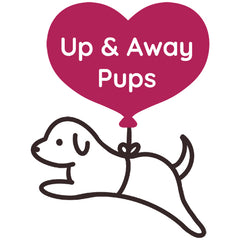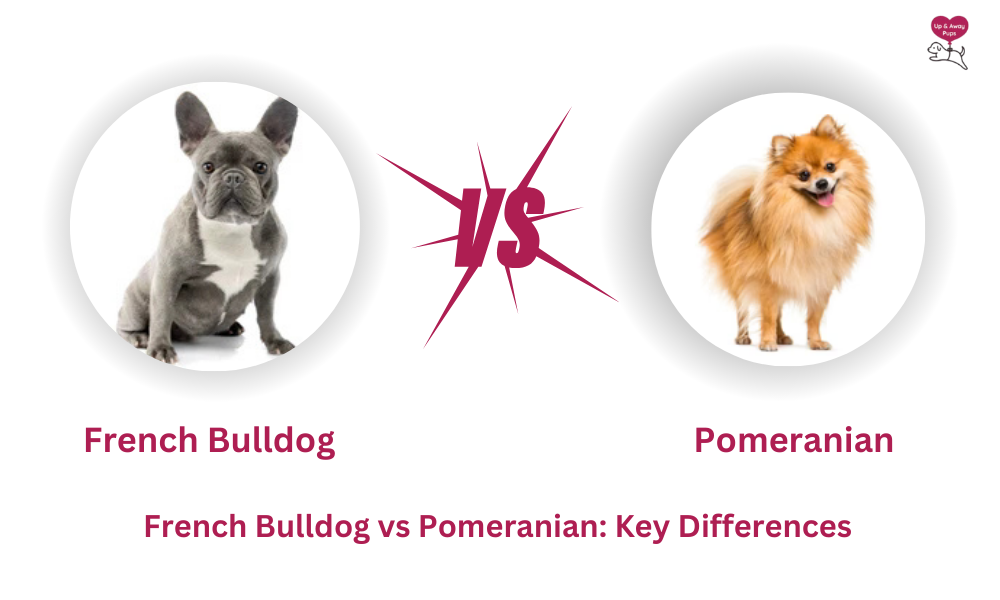French Bulldog vs Pomeranian: Key Differences
Choosing between a Pomeranian and a French Bulldog can be challenging due to their unique personalities. Pomeranians are energetic and bold, with a fluffy coat requiring regular grooming, while French Bulldogs are calm and friendly, though they need extra care for their skin folds. Both breeds fit well in apartments, but their exercise needs and temperament differ. This guide helps you weigh factors like size, energy, and care requirements to make the best choice for your lifestyle.
If you’ve decided to bring home a small dog and you’ve narrowed your choices down to the high-energy fluff ball Pomeranian or the, as we like to call it, flip-of-the-coin French Bulldog, it is just a matter of taking that one final step and selecting one of them. But it is by no means an easy decision. Both dogs are small and lovable, but they’re so distinct in terms of their characteristics, physically and mentally. So, in this blog post, let's break down the key differences between the French Bulldog and Pomeranian to help you decide which is the better fit for your home and personality.
The French Bulldog: The Embodiment of Randomness
Every dog is unique, but there are certain traits about them that do make them similar. For example, Poodles are intelligent, Goldendoodles are love sponges, and French Bulldogs are either crazy or the most chill dog you’ll be around. The common perception about these dogs is that they are incredibly relaxed and low on energy. Well, that is true, but it isn’t a universal fact. Remember how we called them a flip-of-the-coin in the beginning? Well, that’s because they tend to be quite either/or when it comes to temperament. They’re extremely friendly, but they do get a lot of zoomies. So, if you’re expecting a couch potato, the chances are 50/50.
If we talk about their appearance, they’ve got a small bodybuilder appearance with a muscular build. Pair that up with their bat-like ears, and you’ve got yourself quite a unique-looking dog. They’re stocky, sturdy and typically weigh between 16 to 28 pounds and stand around 11 inches tall.

Despite what you might assume, French Bulldogs actually originated from England in the 1800s, where they were bred as smaller versions of the English Bulldog. They were popular with lace workers in Nottingham and eventually made their way to France, where they became a fashionable companion breed. Their charming personalities got them the attention of the French people so much, especially amongst French lace workers. The bond between them became so tightly knit that instead of being named after their place of origin, they’re named after the place that accepted them as a superstar. Aw.
If you're trying to choose between the French Bulldog and another breed, our article on French Bulldog vs. English Bulldog can help you decide which breed fits your lifestyle.
Pomeranian: A Surprise
The thing with Pomeranians is they’re often the very first dog that individuals get, and understandably so. They look like toys, clouds with legs, cotton candy floofs, you get it. However, they’re expecting a cute, loving, cuddly dog, and what do they get? A cute, little, loving, cuddly dog suffering from big dog syndrome.
You see, it might not jump out as obvious, but Pomeranians are actually close relatives to sled dogs like the Alaskan Malamute, Siberian Husky, Samoyed, etc. Hard to believe considering their incredibly small stature? Weighing only about 3 to 7 pounds and standing around 7 to 8 inches tall, that wasn’t always the case, though. The very first Pomeranians came from the province of Pomerania, which is a region of Northern Europe on the coast of the Baltic Sea, and used to weigh as much as 20 to 30 pounds. That all changed after they were bred down by Queen Victoria of England. If you take a look at the Indian Spitz, you can get a hint of what the ancestors of our current-day Pomeranians actually, somewhat, looked like, but even bigger.
With all that considered, their big dog syndrome makes a lot of sense. After all, on the inside, they’re still sled-pulling dogs that aren’t afraid to speak up against others, no matter their size or the other party’s size.
As you explore the lively nature of the Pomeranian, you might also want to check out more about their dietary needs. Tailoring Your French Bulldog's Diet could be a useful guide for any small breed's nutritional needs.
Their intelligence and affectionate nature, along with their compact size, have, over the years, made them one of the most beloved family dogs ever. They’re also affectionately referred to as “Pom Pom.”
So, Which Breed is Right For You?
As we wage on the battle of French Bulldog vs Pomeranian, let’s get to the matter at hand. Which breed is better for you as an individual/family wanting a pup? Let’s consider the following factors:
Size
Both dogs are fairly small and can do quite well living within an apartment. They do not necessarily require a big yard to meet their daily exercise requirements.
Exercise Requirements
Neither dog is known for their athleticism, and nor do they need a ton of it. Despite their sledding past, you won’t find Poms pulling sleds anymore, and despite their muscles, French Bulldogs have never been filmed deadlifting. Both dogs need their daily walks and some playtime for mental stimulation. That is sufficient for them. The Pomeranian's short size means they exert energy too fast, whereas the brachycephalic (short-nosed) structure of the bulldog’s nose means they can have difficulty with strenuous physical activity, especially in hot weather.
Training and Intelligence
Both dogs are quite intelligent but have their respective issues. The bulldog can be rather stubborn and lazy and doesn’t often respond to commands, which may pose a challenge during training. Consistency and patience are key when training a French Bulldog.
On the other hand, Poms are mischievous. Their high intelligence does make them a bit easier to train, but their independent nature may make training a challenge. They respond well to reward-based methods.
Temperament
The French Bulldogs are extremely friendly and do well with strangers, family, kids, and other animals. However, they do sometimes lack in the picking up on social cues department and insist on you playing when you or your other pets have shown they aren’t interested.
Pomeranians, too, are friendly and loving towards their family, but they are quite wary of other animals and strangers. Socializing them early on with a senior pet or other members of the family is quite important so they aren’t always on high alert around people and animals that aren’t their parents.
Grooming Needs
One of the appealing traits of French Bulldogs is their low-maintenance grooming needs. Their short coat doesn’t require much brushing, though regular brushing can help keep their skin healthy and remove any loose hairs. However, their wrinkly face does require extra tending to, as one must regularly clean between the folds to prevent moisture buildup, which can lead to skin infections.

Poms arrive with another surprise, which is they aren’t as needy in terms of the grooming department as one might assume. Whilst they are double-coated, regular brushing is all they really require.
Health Consideration
Both dogs are fairly healthy but have their fair share of issues. The French Bulldog, particularly because of their brachycephalic (flat) faces, have breathing problems, especially in hot or humid weather. They can also suffer from hip dysplasia, intervertebral disc disease, and skin infections due to their skin folds.
Pomeranians are generally healthy dogs, but they are susceptible to conditions such as dental problems, patellar luxation (knee issues), and heart problems like heart murmurs. Their small size means that they can sometimes have fragile bones, so care should be taken during play to avoid injury.
With proper care and regular visits to the vet, both dogs are more than capable of living a long and happy life.
Conclusion
Both the French Bulldog and Pomeranian have their unique traits, and either can make a wonderful addition to the right family. The French Bulldog is calm, friendly, with the occasional zoomies, whereas the adorable but bold personality of the Pom has its own little charm. One cannot go wrong with either pick, but if you have kids or other pets, it is important to dedicate some time to properly socializing and training your Pomeranian so they behave properly.
Similarly, if you’re torn between other breeds like the Pug or Pomeranian, you’ll want to weigh factors like energy levels, size, and temperament to make the best decision
FAQs
Which Breed Needs More Exercise?
Pomeranians have higher energy levels and need more playtime and walks to stay happy. French Bulldogs enjoy short walks and indoor play but can overheat easily, so they require moderate exercise.
Are Pomeranians or French Bulldogs Better for First-Time Dog Owners?
French Bulldogs are easier to care for in terms of grooming and exercise, making them a better choice for first-time dog owners. Pomeranians require more maintenance and training but can also be great for beginners who are willing to put in the effort.
Which Breed Lives Longer?
Pomeranians generally have a longer lifespan, living between 12–16 years, while French Bulldogs typically live around 10–12 years. A healthy diet and proper care can help extend their lifespan.
Are Both Breeds Good with Other Pets?
French Bulldogs tend to get along well with other dogs and pets, while Pomeranians may have a more dominant or territorial personality. Socialization from an early age is key for both breeds.
Which Breed Is Better for Small Apartments?
This is one of those cases where you can’t go wrong with either option. Both dogs are great for small apartments and adjust just fine.


